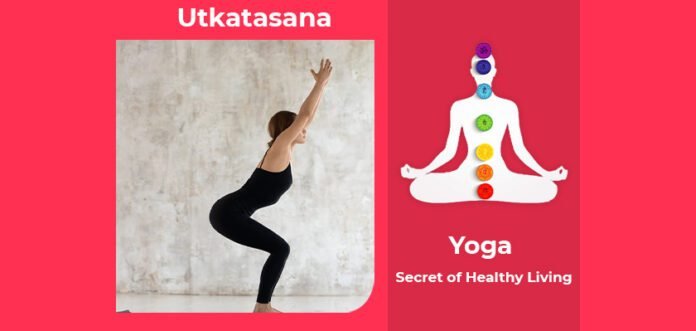What is Utkatasana
Utkatasana Utkatasana is often called “Chair Pose.” To the external eye, it looks like a yogi sitting in an imaginary chair.
- When you do the pose, however, it is definitely not a cushy, passive ride. While bending knees towards downward, immediately the strength of your legs, back, and ankle starts working.
- The literal translation of the word “utkatasana” from Sanskrit is “powerful pose.”
Also Know as: Chair Posture, Difficult Pose, Hazardous Pose, Akward Pose, Fierce Pose, Utkata Asana, Utkat Asan, Hardening Legs Like Steel
How to start this Asana
- From Mountain Pose (Tadasana) bend the knees until the thighs are almost parallel to the floor.
- Keep the buttuck low.
- Bring the arms up towards the ceiling.
- Bring a slight back bend into the upper back.
- Maintain this position for about half to one minute.
How to end this Asana
- Stay for 30 seconds to a minute.
- To come out of this pose straighten your knees with an inhalation, lifting strongly through the arms.
- Exhale and release your arms to your sides into Tadasana.
Video Tutorial
Benefits of Utkatasana
According to research, this Asana is helpful as per below(YR/1)
- Strengthens the thighs.
- Strengthens the ankles, thighs, calves, and spine.
- Stretches shoulders and chest.
- Stimulates the abdominal organs, diaphragm, and heart.
- Reduces flat feet.
Precaution to be taken before doing Utkatasana
As per several scientific studies, precautions need to be taken in diseases mentioned as per below(YR/2)
- Not for the persons who have Headache, Insomnia, low blood pressure.
So, consult your doctor if you have any of the problem mentioned above.
Histroy and scientific base of Yoga
Due to the oral transmission of sacred writings and the secrecy of its teachings, yoga’s past is riddled with mystery and confusion. Early yoga literature were recorded on delicate palm leaves. So it was easily damaged, destroyed, or lost. Yoga’s origins may be dated back over 5,000 years. However other academics believe it could be as old as 10,000 years. Yoga’s lengthy and illustrious history may be split into four distinct periods of growth, practise, and invention.
- Pre Classical Yoga
- Classical Yoga
- Post Classical Yoga
- Modern Yoga
Yoga is a psychological science with philosophical overtones. Patanjali begins his Yoga method by instructing that the mind must be regulated – Yogahs-chitta-vritti-nirodhah. Patanjali does not delve into the intellectual underpinnings of the need to regulate one’s mind, which are found in Samkhya and Vedanta. Yoga, he continues, is the regulation of the mind, the constraint of the thought-stuff. Yoga is a science based on personal experience. The most essential advantage of yoga is that it helps us to maintain a healthy bodily and mental state.
Yoga can help to slow down the ageing process. Since aging starts mostly by autointoxication or self-poisoning. So, we can considerably limit the catabolic process of cell degeneration by keeping the body clean, flexible, and properly lubricated. Yogasanas, pranayama, and meditation must all be combined to reap the full advantages of yoga.
SUMMARY
Utkatasana is helpful in increase flexibility of muscles, improves shape of the body, reduce mental stress, as well improves overall health.




